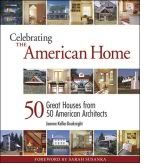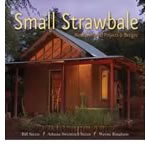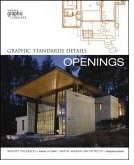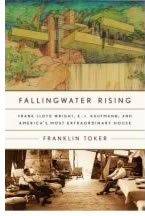

07/2005
The editors each have chosen a book for a mini-review. From the American home to architectural openings to building with straw bale to the story of Fallingwater, we hope you find something you would like to read this summer.
 Celebrating
the American Home: 50 Great Houses from 50 American Architects, by Joanne Kellar Bouknight (The Taunton Press and AIA, 2005)
Celebrating
the American Home: 50 Great Houses from 50 American Architects, by Joanne Kellar Bouknight (The Taunton Press and AIA, 2005)
Culled from the stores of Taunton’s books on home design, the houses
within this collection all share common characteristics that differentiate
house from home: response to place; a comfortable scale; livability;
respect for craftsmanship; and a high level of distinctiveness. “Houses
are perhaps our most fundamental expression of self, the stage on which
our unique story is cast,” says John Connell, architect and member
of the panel that selected the 50 projects from 400 throughout North
America. The showcased homes express the style and whimsy of enlightened
clients and the creativity and functional problem-solving of their architects.
They range from coastal summer retreat to urban oasis to Midwestern utilitarian
and vary greatly in size and materials. With generous illustrations,
panel comments, and text that highlights thoughtful solutions, this book
hails the supreme comfort and livability of individualized, responsive
residential design.
—HL
 Small
Strawbale: Natural Homes, Projects, and Designs, by Bill Steen,
Athena Swentzell Steen, Wayne J. Bingham (Gibbs Smith Publisher, Salt
Lake City, 2005)
Small
Strawbale: Natural Homes, Projects, and Designs, by Bill Steen,
Athena Swentzell Steen, Wayne J. Bingham (Gibbs Smith Publisher, Salt
Lake City, 2005)
These few dozen examples of stuccoed-straw structures are small houses—on
the main, less than a thousand square feet—with walls, outbuildings,
and greenhouses thrown in for the fun of it. Yet they are compelling.
The owner/builder descriptions are esoterically vague at times, and absolutely
adorably fun to read. Mostly situated in the Southwest, where conditions
are arid, as necessary for straw-bale construction, the excellently illustrated
case-study vignettes incorporate urban as well as rural confabulations
(often owner-built) of sustainable strategy. You may never meet a client
who desires this kind of compact relation to nature. But if you would
like to some day, this is your book. As the authors say right from the
start: “A home sized to meet genuine needs—built by the hands
and inspired by the dreams of those who inhabit it—is much more
likely to contain a richness of soul and spirit.”
—DG
 Graphic
Standard Details: Openings, by Wendy Talarico, editor-in-chief
and Smith Maran Architects, Graphics Editor (John Wiley & Sons, Inc.,
2005)
Graphic
Standard Details: Openings, by Wendy Talarico, editor-in-chief
and Smith Maran Architects, Graphics Editor (John Wiley & Sons, Inc.,
2005)
The 152-page book with index and credits is a good reference for any
designer who wants to make an entrance. Publisher Wiley asked architects
to share their best examples of contemporary approaches to entries and
openings. Editor-in-Chief Wendy Talarico organizes 21 recent projects
into six sections: operable walls, vestibule, gateways, interior transitions,
canopies, and sculptural. Complete with images and hundreds of construction
drawings that are typical of the series’ attention to detail, projects
range from the public National Civil Rights Museum Expansion with its
steel gate that bears a quotation from Dr. Martin Luther King Jr. and
a private home in Brazil with an oversized sliding glass door that blurs
the line between indoors and out, to a chiller plant with a wall of simple
galvanized steel grid at the University of Pennsylvania and a twisting
skyway bridge for the Royal Ballet school in London. “[Entrances]
are perhaps the architectural equivalent of the cover of a book, the
face of a woman, or the opening course of a meal. They hold the promise
of what is to come,” writes Horace Havemeyer III, Metropolis magazine
publisher, in the foreword.
—TO
 Fallingwater
Rising: Frank Lloyd Wright, E.J. Kaufmann, and America’s Most Extraordinary
House, by Franklin Toker (Knopf, 2003)
Fallingwater
Rising: Frank Lloyd Wright, E.J. Kaufmann, and America’s Most Extraordinary
House, by Franklin Toker (Knopf, 2003)
Franklin Toker, professor of the history of art and architecture at the
University of Pittsburgh, has created a bountiful biography—not
of the always colorful Frank Lloyd Wright and his merchant-adventurer
client E.J. Kaufmann—but of a house, the extraordinary residence
that AIA members voted in 2000 as the best American building. Fallingwater
rises step-by-step as Toker examines the commission, planning, design,
and building of the house that many say resurrected Wright’s career.
He also analyzes “the hype” and “the buzz” surrounding
the house, as well as its architect, and its famous inhabitants: Kaufmann,
his wife and cousin Liliane, and their son Edward Jr., who inherited
Fallingwater and brought the house to the public. Junior was the Kaufmann
who kept the house in repair even through considerable flood damage and
deeded it to the Western Pennsylvania Conservancy, which has kept it
alive for all of us. Peppered with interesting photos, Toker’s
well-researched and -noted tome delivers smooth-as-silk prose that makes
this fascinating topic a pleasure to read. First choice for the beach
or the hammock this summer.
—SS
Copyright 2005 The American Institute of Architects.
All rights reserved. Home Page ![]()
![]()
 |
||
Click on bookcovers to order from the AIA Store.
|
||